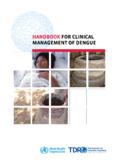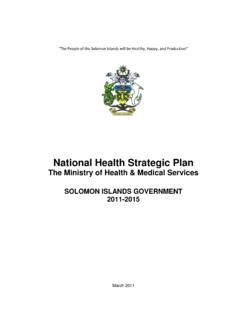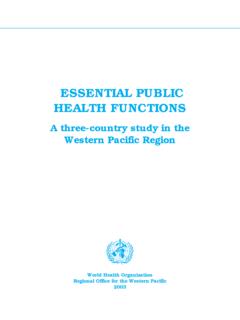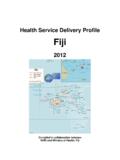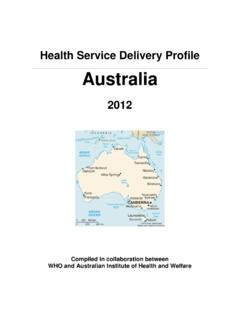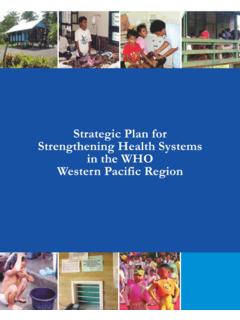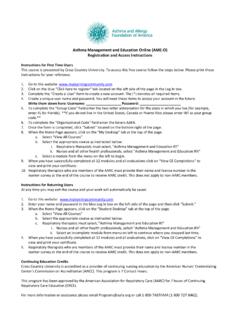Transcription of Developing Health Management Information Systems - WPRO
1 WORLD Health ORGANIZATIONREGIONAL OFFICE FOR THE WESTERN PACIFICD evelopingHealth ManagementInformation SystemsA PRACTICAL GUIDE FORDEVELOPING COUNTRIESiiWHO Library Cataloguing in Publication DataDeveloping Health Management Information Systems : a practical guide fordeveloping countries1. Management Information Systems 2. Guidelines 3. Developing countriesISBN 92 9061 1650 (NLM Classification: WA ) World Health Organization 2004 All rights designations employed and the presentation of the material in this publication do not imply theexpression of any opinion whatsoever on the part of the World Health Organization concerning the legalstatus of any country, territory, city or area or of its authorities, or concerning the delimitation of itsfrontiers or boundaries.
2 Dotted lines on maps represent approximate border lines for which there maynot yet be full mention of specific companies or of certain manufacturers products does not imply that they areendorsed or recommended by the World Health Organization in preference to others of a similar naturethat are not mentioned. Errors and omissions excepted, the names of proprietary products are distinguishedby initial capital World Health Organization does not warrant that the Information contained in this publication iscomplete and correct and shall not be liable for any damages incurred as a result of its of the World Health Organization can be obtained from Marketing and Dissemination,World Health Organization, 20 Avenue Appia, 1211 Geneva 27, Switzerland (tel: +41 22 791 2476; fax:+41 22 791 4857.)
3 Email: Requests for permission to reproduce WHO publications,in part or in whole, or to translate them whether for sale or for noncommercial distribution should beaddressed to Publications, at the above address (fax: +41 22 791 4806; email: WHO Western Pacific Regional Publications, request for permission to reproduce should be addressedto Publications Office, World Health Organization, Regional Office for the Western Pacific, Box 2932,1000, Manila, Philippines, Fax. No. (632 521-1036, email: named author/s alone is/are responsible for the views expressed in this WHO Regional Office for the Western Pacific acknowledges the contributions madeby Dr Ophelia Mendoza, WHO Consultant, and Dr Chong, Regional Adviser inHealth v1 12 The basic 33 Reviewing the existing 54 Defining data 95 Determining the data Designing the data collection and reporting Developing procedures for data Developing the training programme.))
4 259 Pre-testing the Monitoring and evaluating the Developing data dissemination and feedback Enhancing the ..53 ContentsivvAbbreviationsARICPA cute Respiratory Infection Control ProgrammeBCGB acille-Calmette Gu rinCDSSC ommunicable Disease Surveillance SystemCHCC ommune Health CentreDHCD istrict Health CentreDHSD epartment of Hospital ServicesDOFD epartment of FinanceDMCHD epartment of Maternal and Child HealthDPDepartment of PlanningDPTD iphteria-Pertussis-TetanusDSSD isease Surveillance SystemEHEnvironmental HealthEPIE xpanded Programme of ImmunizationFPSFF amily Planning Service FacilitiesHHospitalHACPHIV/AIDS
5 Control ProgrammeHMISH ealth Management Information SystemsMCHM aternal and Child HealthMOEM inistry of EducationMOHM inistry of HealthNINN ational Institute of NutritionNMCPN ational Malaria Control ProgrammeNSON ational Statistics OfficeNTCPN ational Tuberculosis Control ProgrammeOPVOral Polio VaccineORSOral Rehydration SaltsPHCP rimary Health CentrePHOP rovincial Health OfficePMCP reventive Medical CentreTTTetanus Toxoidvi1 Purpose of the ManualThis Manual is designed to be a quick-and-easy, user-friendly reference for thedevelopment of Health Management Information Systems (HMIS), with the focuson applications.
6 It serves as a primer on HMIS development and provides a generaloverview of the basic principles, as well as the fundamental steps and issuesinvolved in the different activities to be undertaken. The Information is presentedin a concise, direct-to-the point, easy-reading, and outline format. It aims simplyto provide the basic elements on HMIS development for people who do nothave the time or the need to read deeply on the subject. For those who wish todevelop a more in-depth knowledge, the Manual can also serve as the springboardfor further reading and Users of the ManualThis Manual was designed with the following persons in mind.
7 Heads and staff of Statistics Units at the national, provincial, or even thedistrict Health service level who are actively involved in the development oftheir HMIS People who do not have the in-depth background on HMIS but need to havea general overview of its components because they are members of Multi-disciplinary Committees tasked with overseeing the development of the HMISin their country Managers and staff of vertical programmes whose responsibilities includeany component of the Information system of their respective programmesScope and Style of the
8 ManualEach chapter in this Manual has four parts:(a) Principles(b) Steps(c) Issues(d) Worksheets1 Introduction2 The worksheets give the reader an idea of how to go through the different steps,or how to process the different issues in an organized and systematic entries for the worksheets are provided to demonstrate how they arefilled last part of the Manual gives an example of a list of basic indicators thatmight be used in Ministry of Health programmes, together with the correspondingdata sources, modes and frequency of data collection.
9 As well as the lowestadministrative level where the indicator is computed. While the reader can adoptsome of these indicators for their use, the main objective of the example is toshow how the set of indicators used by a country can be presented so that it willbe easy for the staff of the Statistics Unit to monitor their status. Also providedat the end of the Manual is an example of a flow chart of the HMIS of hypotheticalcountry X. As in the first example, the aim is to show not what , but how ;not to prescribe a model flowchart for the HMIS as such, but rather to demonstratehow the HMIS can be presented by means of a flow DefinitionsSystemA collection of components that work together to achieve a commonobjective1 Information SystemA system that provides Information support to thedecision-making process at each level of an organization2 Health Information SystemA system that integrates data collection,processing, reporting.
10 And use of the Information necessary for improving healthservice effectiveness and efficiency through better Management at all levels ofhealth services3 Health Management Information SystemAn Information systemspecially designed to assist in the Management and planning of healthprogrammes, as opposed to delivery of care4 Steps in Developing a Health Management Information System(1) Review the existing system(2) Define the data needs of relevant units within the Health system(3) Determine the most appropriate and effective data flow(4) Design the data collection and reporting tools(5) Develop the procedures and mechanisms for data processing(6) Develop and implement a training programme for data providers and datausers(7) Pre-test, and if necessary, redesign the system for data collection, data flow,data processing and data utilization(8) Monitor and evaluate the system(9) Develop effective data dissemination and feedback mechanisms(10)
